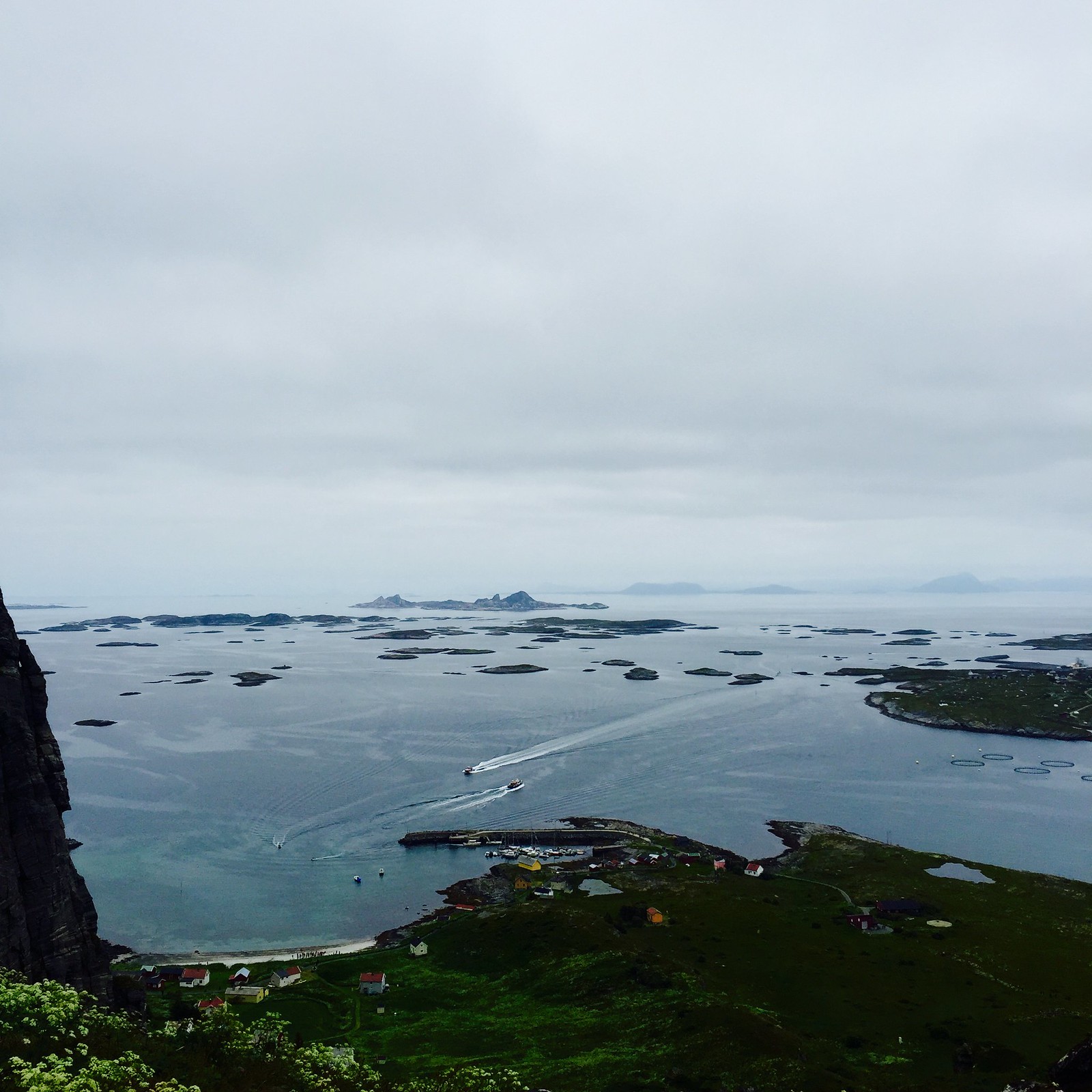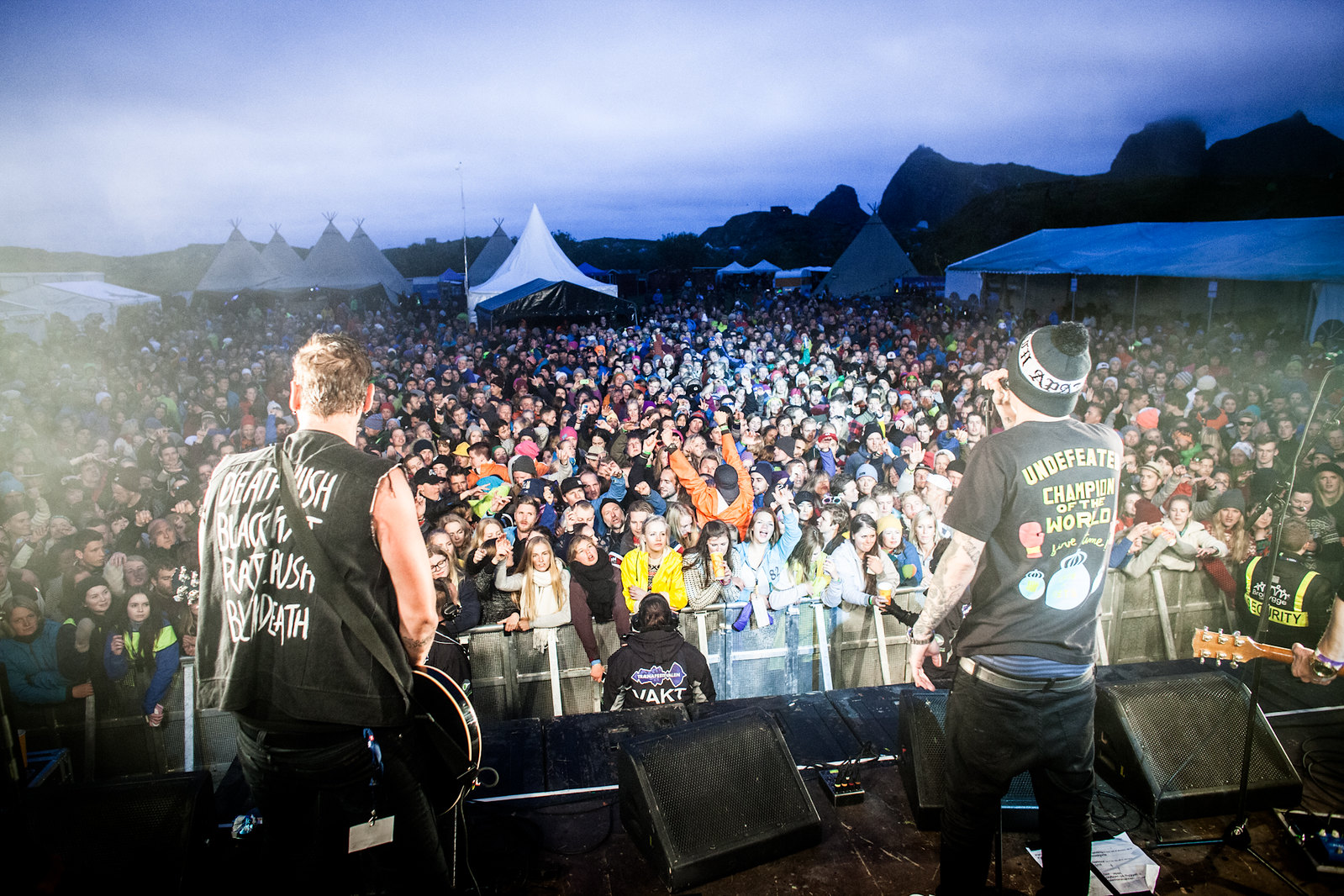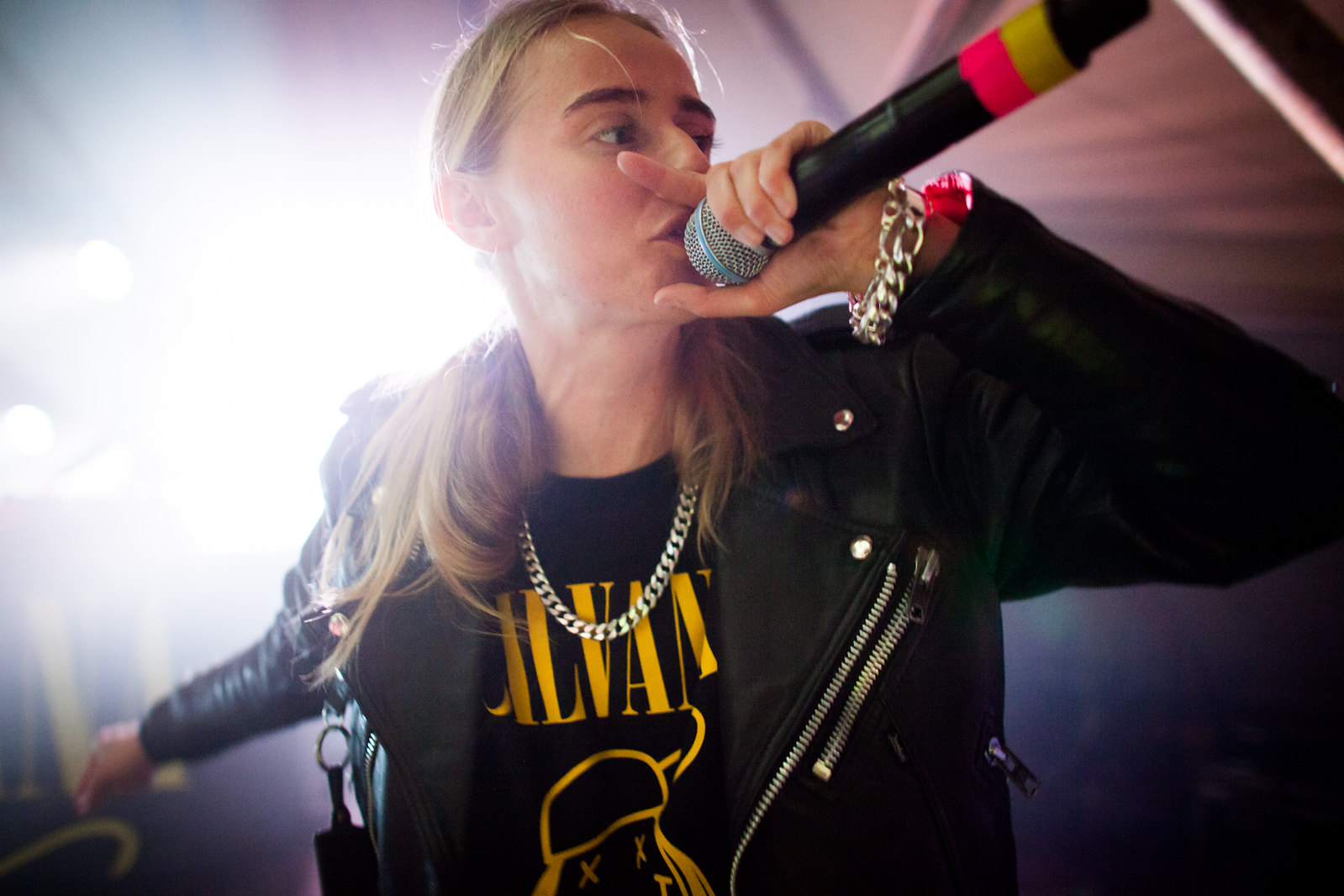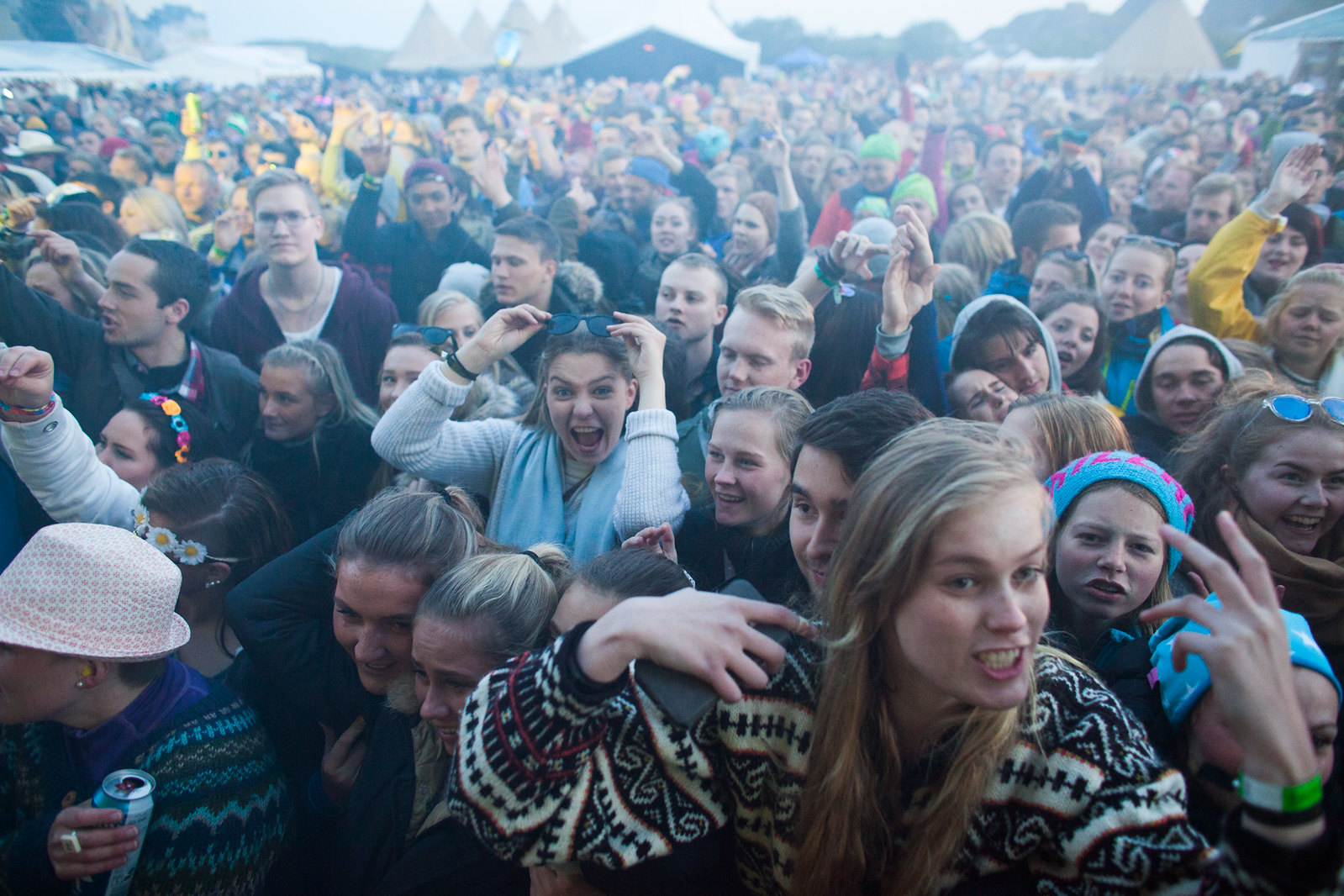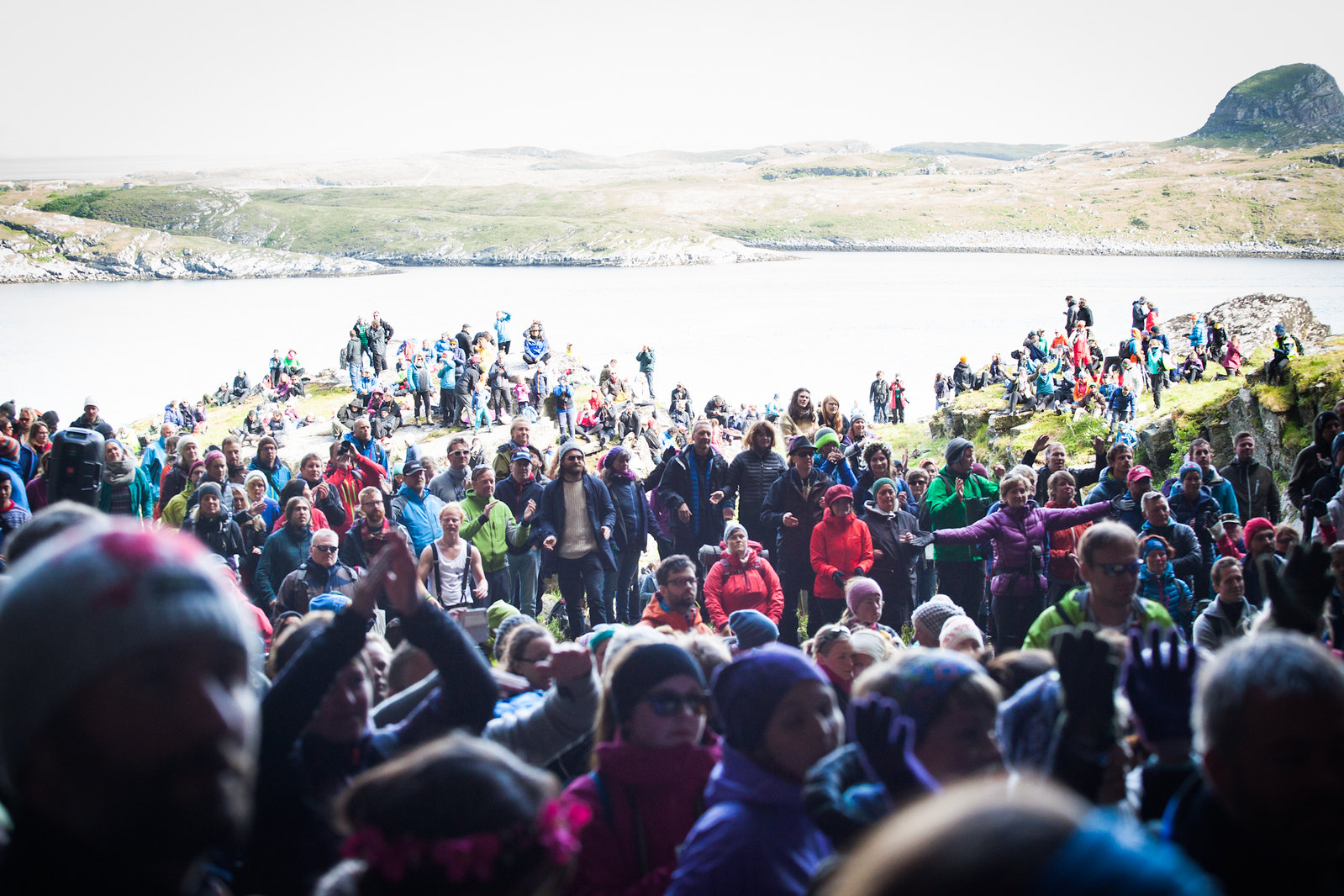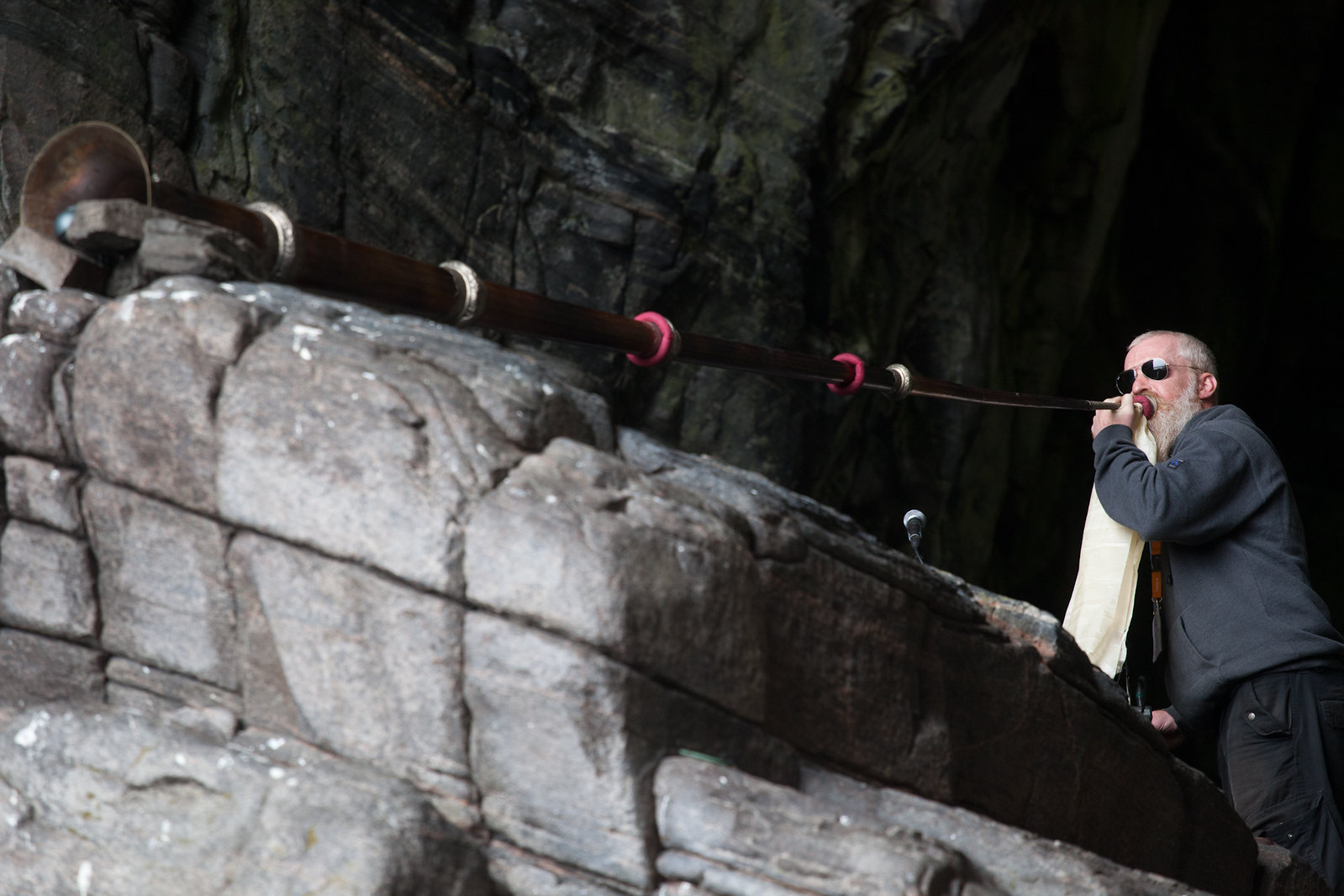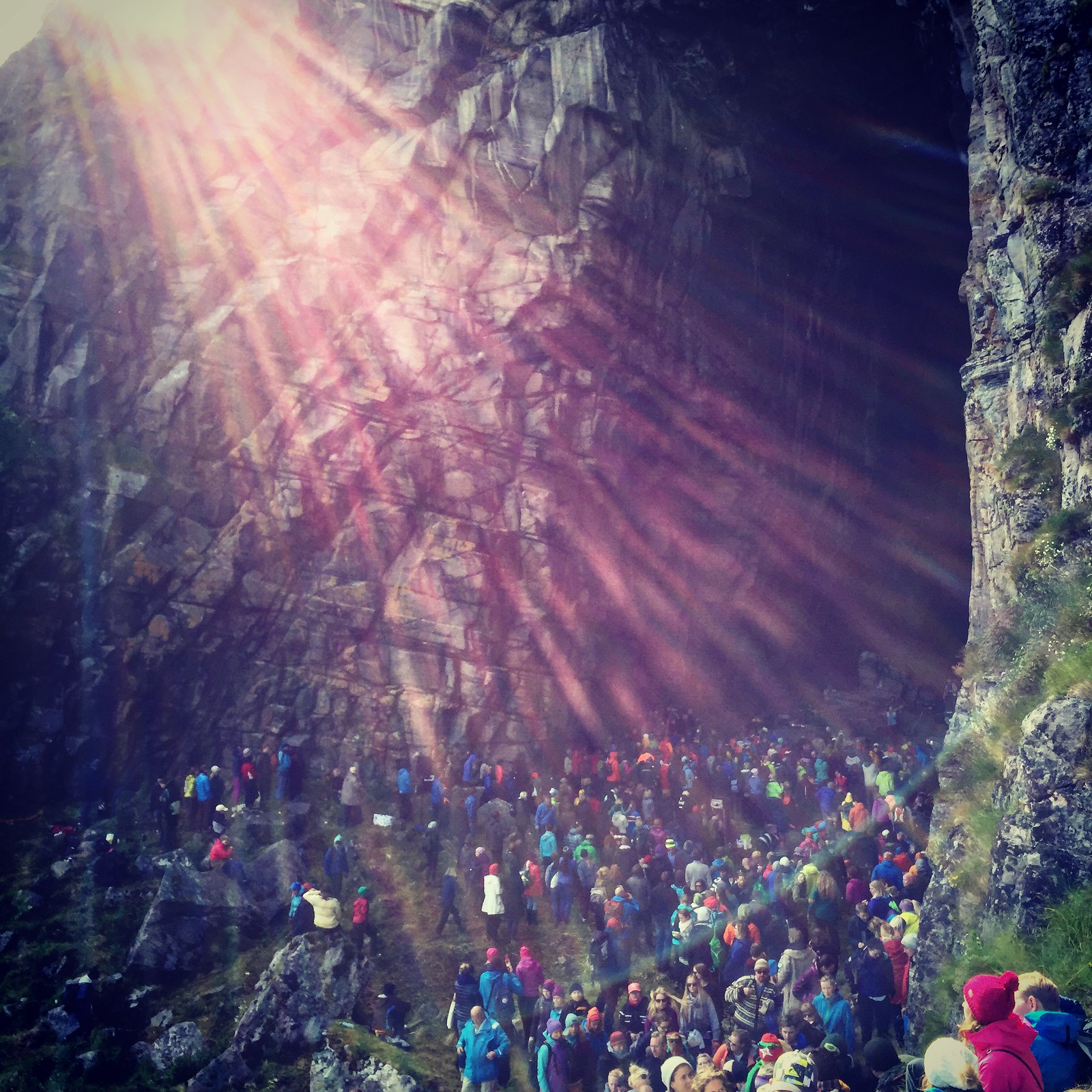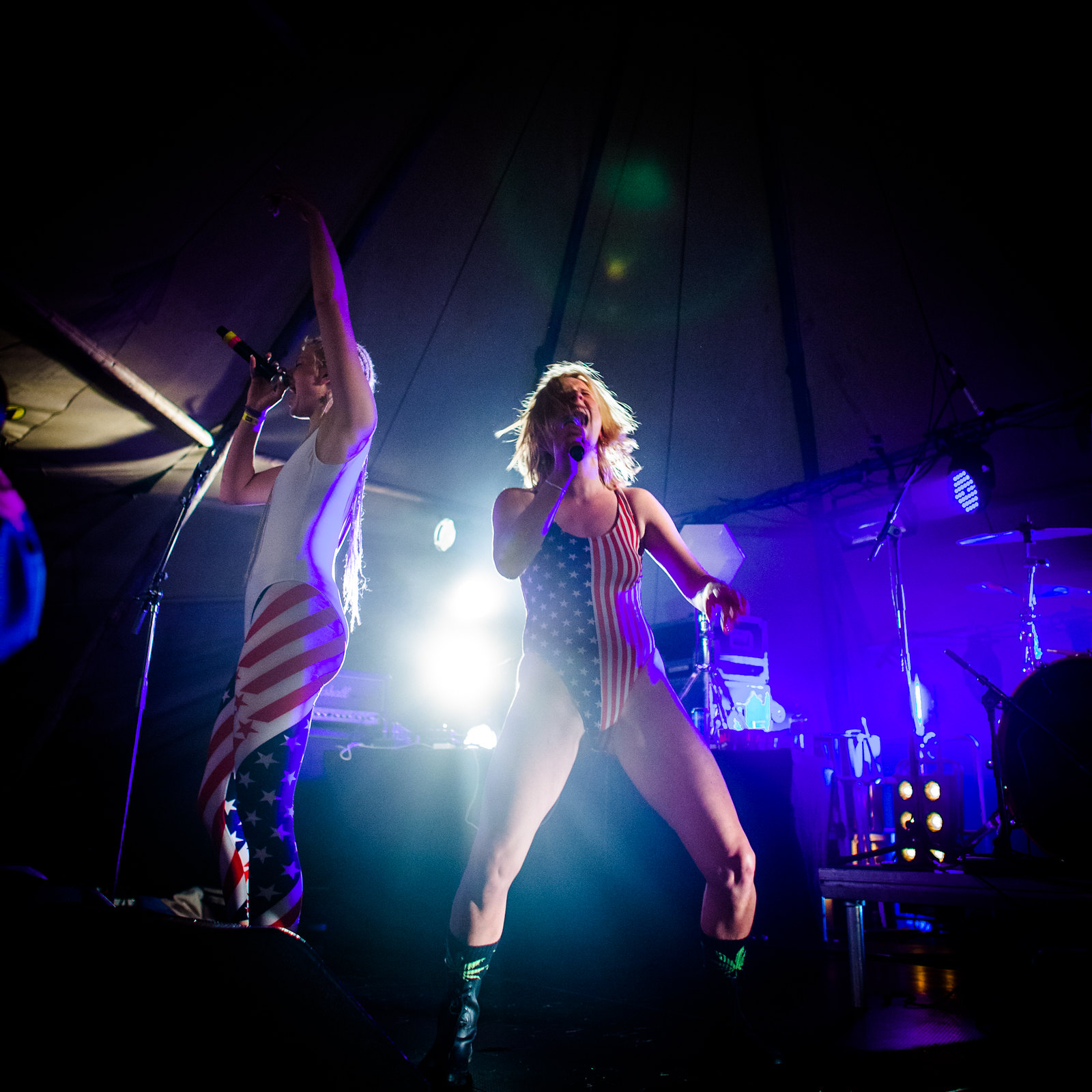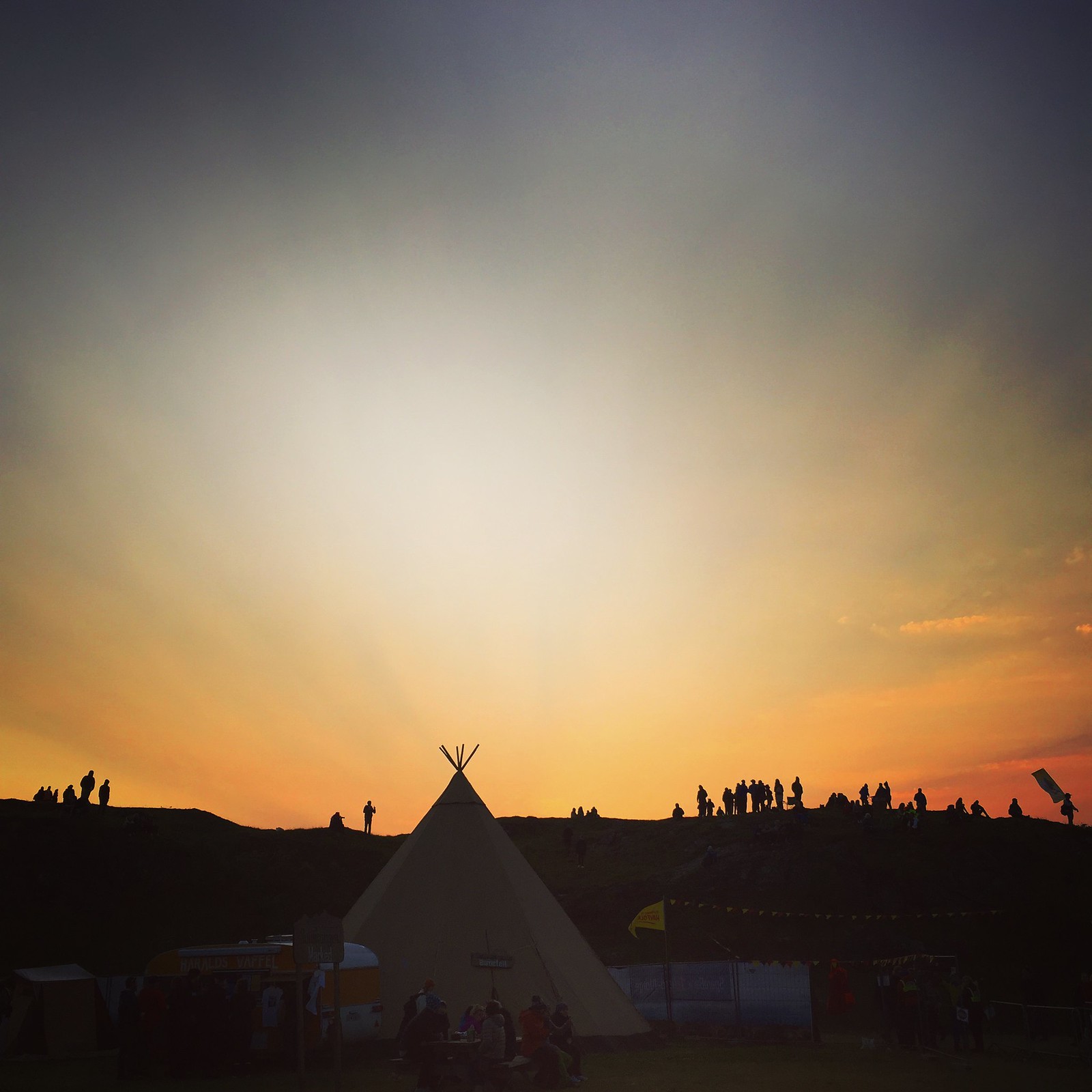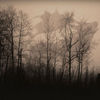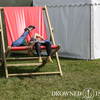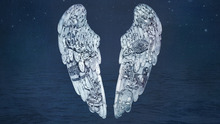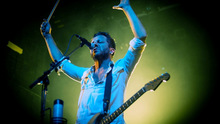On a good day, the flight into Bodø airport is one of the most stunning descents there is. With the Saltfjellet-Svartisen National Park to the right, and countless fjords jutting out into the vast, deep blue nothingness of the Norwegian Sea to the left, it is a landscape like no other. It may only be an hour and a half’s flight from genteel, urbane Oslo, but it feels like a different world; raw and rugged, there are snowy peaks, sheer cliffs, emerald green hillsides and roiling surf, all very Lord-of-the-Rings-meets-Moby-Dick.
Sadly, today is not a good day. A thick blanket of cloud lies flat and wide, obscuring all but the highest mountains from view. As we slide through it, the town itself comes into view, low and squat, clinging to a narrow peninsula. The airport sits at its very point, the runway ending just a few metres from the sea. As we taxi towards the terminal, I notice a few fighter jets dotted around the tarmac; I will later learn that the military have always been particularly active in the north of the country. As if to emphasise the point, the first plane to take off after we land is a large, turboprop army transporter, the dark green hulk of the fuselage skimming low over the sea wall as it roars past.
As we disembark, I’m not alone in feeling apprehensive; several people who are wrestling with flight cases and musical instruments are also glancing nervously at their watches. The reason? Our ferry to the Træna archipelago, and the world’s most remote music festival, leaves at 3pm, but it’s already gone half past. The festival’s jovial press officer, Wyndham Wallace, has assured me that the crew are aware of the delay and will wait, but it’s been a long day already – I left home at 5.15am – and the prospect of missing the last boat is not appealing. But we needn’t have worried; ten minutes later we spill out of a taxi to find the captain stoically smoking a cigarette on the pier, shirtsleeves flapping in the brisk, chilly breeze. “We go now, yes?” he barks as the last of the cases are loaded on. This is our “Welcome to TrænaFestival”, a self-contained little world where everything works out for the best; the only thing to do is surrender oneself to its charms and enjoy the ride.
Erland Mogård-Larsen is an unlikely candidate for festival impresario. A hardy, seafaring type (havfolket in Norwegian) whose grandmother lived on Husøya, the largest of the archipelago’s islands, he remembers standing in Kirkhelleren – a stunning, 30 metre-high limestone cave that housed the first settlement here 10,000 years ago – and thinking: “How cool would it be to play electric guitar in here?” Then, aged twelve and obsessed with the Woodstock triple LP, he fantasised about putting on a festival on the island. Twenty-two years later, his dream became a mad, eclectic reality that’s now in its 13th year.
“The travel, and the experience on the way here, is 50% of the festival experience,” he told Vice in 2013, and he’s not wrong; no matter where you’re coming from, getting there is a Planes, Trains & Automobiles-esque odyssey in itself. Stepping aboard the Falkefjell, my fellow intrepid souls are evenly split between those keen to get the party started and those who already look like they need to sleep for a week. As we set sail, a group of girls with enough beer and cigarettes to power an army set up camp on the top deck. Another individual who I can only assume is an artist – sadly, he’s never free enough for me to actually ask – seems to be conducting a running interview and spends all three-and-a-half hours being questioned by a photographer, the camera never more than twelve inches from his face. There’s also another snapper, who is a constant presence wherever I roam during my three days in the Arctic, and he wastes little time in changing into his festival “uniform”; deerstalker hat, Hawaiian shirt, cargo shorts, and a manic grin. This is his only defence against the plunging temperatures and blustery conditions as we pick up speed.
I’d been warned that despite it being summer, the sea can get pretty wild and choppy; apparently chewing on fresh ginger helps those not blessed with sturdy sea legs stave off nausea. But as we glide between vertiginous cliffs shrouded in mist and cloud, the turquoise blue depths remain benign despite the overcast conditions. Even the open sea is relatively calm, although standing out on deck, staring at the vast expanse of nothing, it’s easy to see how scary being stuck in a storm would be; any wave above a couple of metres would toss our boat around like a toy in a bathtub. I retreat inside, find a spot on the floor, and wedge myself in between some bags beside a window.
“Don’t sit on the floor man, there’s a seat here.” My attempt to take a quick nap is almost instantly interrupted by a blond Norwegian wearing a vintage cycling cap, shorts, and idly plucking at a bass guitar. Next to him, two women lie sprawled across several seats, fast asleep. I assure him I’m comfortable, and there’s no need to wake his friends, but he’s insistent. They rouse themselves, sleepily re-arrange their bodies into an even more intricate form of human Tetris, and nod off again. I slide into the vacant space and strike up a conversation; the generous stranger is Ole Øvstedal, bassist in Norwegian band KUUK – it’s slang for “cock” – a confrontational electro-rap collective who I will see at the centre of just about every party and dancefloor over the weekend, and who’ll also deliver one of the festival’s most intense, in-your-face sets. He helpfully translates the captain’s frequent messages, and I drift in and out of sleep as we near our destination. Save for an unnerving ten minutes spent adrift after our engine overheats, the crew running below deck amid alarm bells and nervous glances, the rest of the journey is serene and uneventful. I collect my bag, rub the sleep from my eyes, and stumble up the gang plank towards the throng of people gathered by the harbor office. Adventure lies ahead.
It's ten degrees, raining, and I'm standing on the local football pitch that’s been transformed, as it is once a year, into the main “arena”. Gracing the stage is Nora Konstanse, a singer songwriter whose pastoral lilt and gentle melancholy perfectly complements the greying skies and horizontal drizzle. A short while later, crammed into the glorified tee-pee that is the second stage, Syv Søstre, my ears are assaulted by the industrial drone of Sysselmann – real name Thomas Narverud – who looks and sounds like he's birthing a whole new genre, Nemo-wave: a violent remix of deep ocean sounds combined with seagull calls and a looped penny whistle. Next to me, watching this unfold, is a girl smoking a pipe. After an intense twenty minute set, we shuffle back out into the elements to Carnival Kids, a melodramatic EMO rock outfit. The singer, Jethro Fox, spends most of the set mooching around the front of the stage screaming into his mic, his floppy fringe obscuring his face. It’s very theatrical, if a little rote, the sort of music that appeals to teenagers with a burning desire to paint their bedrooms black.
If ever a line-up was designed to stretch the concept of “eclectic” past breaking point, this is it. Træna, though, isn’t just a music festival. For the majority of the people here, the music is simply an excuse to visit a breathtakingly beautiful part of the world they may otherwise never see. There are some for whom Træna has become an annual pilgrimage; I meet several who insist they wouldn’t miss it for the world. There are others who come despite not having a ticket for the festival proper, and make their own midnight-sun-powered mischief. Visitors are permitted to pitch a tent – any tent – wherever they want on the island; and everything goes. We pass one gazebo that, daubed in fluorescent neon spray paint, has been turned into a twenty-four hour rave tent. Another, completely blacked out, blares foreboding death metal and classic rock; we neglect to peak inside.
Lured back by the splendor and magic that hangs in air, this is their Wonderland, a suspension of the reality of everyday life. There’s a camaraderie between everyone present, a bond that manifests itself in knowing looks and nods that suggest we’re in this together, one for all and all for one; “Yeah, you get it. You understand.” The majesty of Træna seeps into your very soul and, as with war, can’t be explained; it can only be properly comprehended once experienced. To face the rawness of nature and the harsh reality of life on this island is to be humbled, and reminded of our fragility on this little rock we call home.
That’s not to say the festival is full of drug-addled, tree-hugging hippies who’ve spent too long chasing Nirvana from Goa to Burning Man; far from it. In fact, the weekend is remarkably narcotic free. This is due to two main factors; to get here, most people have had to take a plane (and therefore brave airport security), and the Norwegians’ somewhat puritanical stance on substances stronger than alcohol. “They’re luxuries,” I’m told, when I query the eye-watering price of booze and cigarettes, “and so people here think they should be expensive.” Extrapolate that attitude out, and it’s no surprise to learn of people being fined several hundred euros and immediately deported back to the mainland, just for smoking a joint. Rumours abound that a few brave souls have succeeded in smuggling something ashore – naturally described as “a friend of a friend” – and one band allegedly come close to pulling their set due to the absence of weed, but there’s precious little misadventure to be had; perhaps just as well, considering the topography and the range of things one could fall down, off, or into.
What there is though, is beer; industrial quantities of it, despite the mammoth queues at the island’s only shop and, within the festival site itself, a €9 price tag. Almost everyone I pass, meet, or talk to has a beverage on the go, and while the local café does a roaring trade in coffee and delicious looking pizzas, there’s a sense that people are simply attempting to jump start their nervous system before going in on another bright blue can of Isbjorn, a product of, fittingly, the world’s northernmost brewery. A patch of ground on a hill overlooking the main stage is commandeered by those who brought, and are happy to share, hard liquor; from here we watch Kristian Kristensen, winner of the Norwegian version of The Voice, run through his upbeat, bouncy pop, sipping on vodka and apple juice. Later, having snuck our bottle past security, we swap some with a French student who’s “bored” of her bottle of Jägermeister and do communal shots. Like I said, one for all and all for one.
For these three days, the whole island gets involved. Local children pushing large carts offer a rudimentary taxi service for a few krone, and many others rent out rooms, or even their entire house. One particularly large dwelling seems to be housing the entire bar and restaurant staff, its large garden and patio – complete with hammock – the unofficial centre for the hardcore, 24-hour party people. Every time we pass, there’s something going on, a certain Mr. Øvstedal and his bandmates usually chief among the protagonists. Ivar Andreassen, a sturdy, bespectacled man in his mid-fifties who could easily pass for a friendly family lawyer, has gone one further; his vintage fishing boat, moored at the very end of the harbor, past the bored looking coastguards and a dilapidated herring factory, is opened up for a free bar and barbecue every night. Unsurprisingly, it’s incredibly popular – the party continues long after all other sources of music and booze have closed – but as he’s never had a Scot on board, he takes pity and let’s us jump the queue. It’s ten feet to the deck below down a wet, rickety ladder, but it’s worth it; within seconds, we’re offered a beer and ushered towards the front where a huge, concave hotplate is being used to fry whale meat and eggs. “Ever had whale?” asks the jovial chef as he thrusts a plate of food into my hand. “I’m sure you’ll like it!” He’s right, I do; it is absolutely delicious. Meaty but lean, with just a hint of game, the dark red whale is as good as the finest steak; the 3am setting, the views over the harbor, and the ice cold beer makes it one of finest meals I’ve ever had, anywhere.
The music spills out across the island too; aside from Kirkhelleren, a couple of churches are pressed into service as alternative venues. The tiny Petter Dass Kapellet holds twenty at a squeeze, and is only used for a couple of book readings. Træna Kirke, however, is a far grander affair, a beautiful white, all-wooden church complete with organ, a toy sailing ship hanging from the ceiling, and two balconies. Used to deliver sermons to whaling crews before they embarked on yearlong journeys, the air inside hangs heavy with a sense of solemnity and loss and the pews sing with the satisfying creak of age-old wood; the whole place feels like a living, breathing entity.
It’s the perfect setting for Torgeir Waldemar, a singer songwriter with a dark glint in his eye and a storm brewing on his fingertips. Singing in perfect English, his music brings to mind the brutal beauty and despair of Townes Van Zandt; there’s tension in his songs, and even when he lets a little light in, you sense that the relief won’t last long. Stood before the pulpit, Waldemar is preaching, and for just under an hour we’re happy to be his flock. His cathartic swirls and fire & brimstone drama ebb and flow, beautifully complemented by Ida Jenshus and Johan Daniel Henriksen on harmonium, organ, slide guitar, and musical saw. “I’ll go down on my knee for you” he sings on ‘Streets’, and together with ‘Insomnia’ and ‘Across the River’ – similarly epic tales of lost love, pain, and redemption – leaves us all quietly awed.
The hushed reverence and quiet introspection is repeated a day later at Kirkhelleren, the Cathedral Cave. Located on the slightly smaller island of Sanna – the only place in the entire archipelago that boasts a sand beach – it is a setting so unique that it’s usually reserved for the festival’s biggest names. It’s a highlight among many, and as such, getting the majority of the 3,500 in attendance the short distance across the water is something of a logistical nightmare. But all for one and one for all; virtually every craft that isn’t a working fishing vessel – from actual ferries down to 8-person Rib boats – is pressed into service, shuttling people from harbour to harbour as fast as their engines allow. Once back on dry land, we’re treated to yet more hospitality; the locals set out stalls selling homemade pancakes and freshly brewed coffee. I dig in, and eat mine with lashings of cream and strawberry jam, much needed energy for the next part of our “journey”.
To get to the cave is relatively straightforward, if you want it to be; it’s a simple ten minute walk as the crow flies. But we have different plans; we’re headed for the Tunnel of Love. During the Cold War, one of Sanna’s three peaks was chosen to house a Nato base station, and to aid construction and access, a tunnel was drilled up through the adjacent hill, half a kilometre of dank, pitch-black passageway that’s as steep as 40 degrees in places. It’s not the best thing to attempt on five hours sleep and nursing a hangover, but at least the organisers lay paraffin candles to make it (slightly) less claustrophobic. After 100 metres, I’m out of breath; by the end, my thighs are on fire and it appears my lungs have stopped functioning. But the views from the top are worth it, a stunning 360 degree panorama that photos simply can’t do justice to. Sweaty but elated, we face the descent, an equally tricky proposition; straight down the side of the hill, with only rudimentary rocks and an iron guide cable for help. It’s a hell of a workout, and brings us right to Kirkhelleren’s mouth.
Thirty metres high and forty metres deep, the cave itself is a natural wonder. Said to be the site of the first ever settlement on the island, nearly 10,000 years ago, it holds a special place in the hearts of the islanders; acoustic levels are carefully watched, lest any permanent damage is done to the rock structure. First up is Sysselmann – again – who this time has brought along a 12 foot long goat horn to play and loop. It’s bonkers but brilliant, exactly the kind of madcap nonsense that shouldn’t work but gloriously does. The rapturous ovation he receives sets the mood nicely for Anneli Drecker, the former singer of 80’s dreampoppers Bel Canto and erstwhile vocalist with Röyksopp, here to launch her new solo album. Her ethereal voice and sweet, acoustic pop are easy on the ear, if a little predictable; “safe” sounds like an insult, but it’s the sort of music that gives you a warm, fuzzy glow, beautifully structured and arranged to be simple yet effective. And, as if approved from up high, the sun makes its first appearance of the festival halfway through her set, drenching the cave in wonderful golden rays.
Madness and debauchery are in the air for Træna’s last day. The bright blue skies are only occasionally sullied by little fluffy clouds, and despite the temperature – it’s still a two-sock-and-thermal-underwear situation – spirits are high. Several people go skinny dipping in the harbour, but as inviting as the crystal clear waters are, a combination of modesty and a chill wind prevent me from joining them. For reasons that remain unclear, the majority of the ferries leaving for the mainland have been scheduled for early the next day – and by early, I mean 6 or 7am – so the plan is simple; stay up, and keep partying. It is, so I’m promised, going to be quite the night.
The key for any band playing here is simply to keep it entertaining. Having to compete with Arctic scenery needs broad strokes that are bold and brash; subtlety and nuance are somewhat lost on our collective ADHD. The artists who do stick in the mind – the feminist thrash-punk din of The Cameltoes, or the thick-as-sludge post-metal of Kollwitz – have a visceral edge that pins you down and demands attention. Next to this, the standard indie-pop of Casa Murilo and Highasakite are rendered somewhat forgettable, their songs carried off on the wind as quickly as they wash through your mind. But two bands attack their set with a ferociousness bordering on insanity, and leave indelible marks on all who witness them.
KUUK, who have been talked up all weekend, finally have their time to shine. They don’t disappoint. Brash, combative, and pulling no punches, they are a revelation, and have some of the crowd literally swinging from the rafters. With vocalists Mira and Ragna prowling the stage in their distinctive Stars and Stripes outfits – a wry comment on American cultural imperialism no doubt – they spit their lyrics with an anger and conviction rarely seen. Topics covered include LGBT equality, feminism, and race; it’s refreshing to see such issues tackled, and with such passion, especially during a festival set. By the time they’re done, the multitude of crazed grins and sweat-soaked brows is testament to their impact.
Equally as impressive are Norwegian rock’n’rollers Pandemi, but for entirely different reasons; mainly, that no one dies during their set. I’d been told to expect “something spectacular”, and my interest was piqued when I clocked the industrial sized chainsaw sitting at the side of the stage. So far, so weird. It’s one thing to start carving up a tree stump, mid-set, as bassist Stian Antonsen does with an enthusiasm bordering on the manic, but what follows is so batshit crazy and downright stupid that it almost deserves a Darwin Award; kneeling, with an apple in his mouth, singer Erlend Førre – who apparently isn’t even in the band normally – lets Antonsen first carve a smiley face into the fruit before the bassist theatrically slices it in half, the chainsaw inches from Førre’s nose. And for an encore? The roadies wheel a fresh, two-meter stump on stage, which Antonsen promptly fashions into a drinking goblet – during a song – before filling it with three bottles of champagne and dragging the festival organiser on-stage to drink out of it.
I meet them later, on the way to the harbor. Clutching a crate of beer and some pyrotechnic gear, they’re planning more mayhem. As a closing ceremony of sorts, a statue that sits out in the water is to be set ablaze; Pandemi seemed like the perfect guys to do the deed. “Yeah, even our friends think we’ve gone too far,” Førre sheepishly admits when I quiz him about the wisdom of what we’ve just witnessed. I want to ask Antonsen the same, but he’s busy guzzling beer and playing with fire; the wicked glint in his eye suggests he’s in his element, and not to be distracted. They paddle out to the monument, and the top is lit. On the shore, we watch the flames and smoke dance in the amber dusk; no one speaks. As the fire burns, people drift off one by one, seeking out one last high before reality calls us all home.
On the far side of the island, atop a small hill, stands a sculpture of an elk cast in brass. Head held high, he stoically gazes out across the sea. Legend has it that one day an elk arrived, having swam all the way from the mainland, supposedly searching for a partner. For days, he roamed the grassy mounds and quiet inlets, but to no avail; being the only animal of his kind, his love remained unrequited. Having grown desperate, even attempts to befriend the local cattle population failed, thwarted by an over-protective farmer. Eventually, he retreated to a hill – the same one on which the sculpture now stands – and spent days just staring at the vast expanse of water, heartbroken and alone. And then, as suddenly as he’d arrived, he was gone, never to be seen again. Locals say he swam Westward, determined that his quest should be successful. I hope the elk found his happiness. At Træna, I found mine.
https://www.trena.net/
All photos by Kristian Sivertsen


